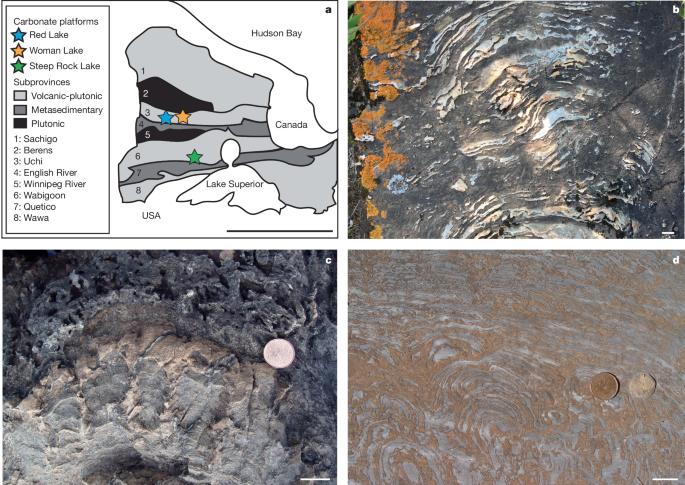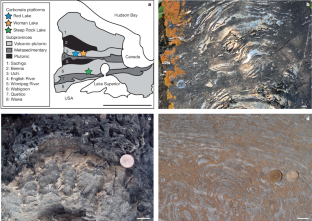Dating the evolution of oxygenic photosynthesis using La-Ce geochronology
IF 48.5
1区 综合性期刊
Q1 MULTIDISCIPLINARY SCIENCES
引用次数: 0
Abstract
There is ongoing debate as to when oxygenic photosynthesis evolved on Earth1,2. Geochemical data from ancient sediments indicate localized or ephemeral photosynthetic O2 production before the Great Oxidation Event (GOE) approximately 2.5–2.3 billion years ago (Ga), and currently suggest Archaean origins, approximately 3 Ga or earlier3–9. However, sedimentary records of the early Earth often suffer from preservation issues, and poor control on the timing of oxidation leaves geochemical proxy data for the ancient presence of O2 open to critique10–13. Here, we report rare Earth element data from three different Archaean carbonate platforms preserved in greenstone belts of the northwest Superior Craton (Canada), which were deposited by the activity of marine photosynthetic bacteria 2.87 Ga, 2.85 Ga and 2.78 Ga. All three indicate O2 production before the GOE in the form of significant depletions in cerium (Ce), reflecting oxidative Ce removal from ancient seawater, as occurs today14. Using 138La-138Ce geochronology, we show that La/Ce fractionation, and thus Ce oxidation, occurred at the time of deposition, making these the oldest directly dated Ce anomalies. These results place the origin of oxygenic photosynthesis in the Mesoarchaean or earlier and bring an important new perspective on a long-standing debate regarding Earth’s biological and geochemical evolution. 138La-138Ce geochronology shows that La/Ce fractionation, and Ce oxidation, occurred at the time of deposition, placing the origin of oxygenic photosynthesis in the Mesoarchaean or earlier.


利用La-Ce年代学测定含氧光合作用演化的年代
关于含氧光合作用是何时在地球上进化的一直存在争论1,2。来自古沉积物的地球化学数据表明,在大氧化事件(GOE)之前,大约25 - 23亿年前(Ga),光合作用产生的氧气是局部的或短暂的,目前认为起源于太古代,大约3 Ga或更早的3,4,5,6,7,8,9。然而,早期地球的沉积记录往往存在保存问题,并且对氧化时间的控制不力,使得古代O2存在的地球化学代理数据受到批评10,11,12,13。本文报道了加拿大上克拉通西北绿岩带中保存的三个太古宙碳酸盐岩台地的稀土元素数据,这些台地是由海洋光合细菌在2.87 Ga、2.85 Ga和2.78 Ga的作用下沉积的。这三种情况都表明,在GOE发生之前,以铈(Ce)大量消耗的形式产生了O2,反映了古代海水中氧化铈的去除,就像今天发生的那样14。利用138La-138Ce年代学,我们发现La/Ce分馏和Ce氧化发生在沉积时期,使这些Ce异常成为最古老的直接测年Ce异常。这些结果将含氧光合作用的起源置于中古宙或更早,并为长期以来关于地球生物和地球化学演化的争论带来了重要的新视角。
本文章由计算机程序翻译,如有差异,请以英文原文为准。
求助全文
约1分钟内获得全文
求助全文
来源期刊

Nature
综合性期刊-综合性期刊
CiteScore
90.00
自引率
1.20%
发文量
3652
审稿时长
3 months
期刊介绍:
Nature is a prestigious international journal that publishes peer-reviewed research in various scientific and technological fields. The selection of articles is based on criteria such as originality, importance, interdisciplinary relevance, timeliness, accessibility, elegance, and surprising conclusions. In addition to showcasing significant scientific advances, Nature delivers rapid, authoritative, insightful news, and interpretation of current and upcoming trends impacting science, scientists, and the broader public. The journal serves a dual purpose: firstly, to promptly share noteworthy scientific advances and foster discussions among scientists, and secondly, to ensure the swift dissemination of scientific results globally, emphasizing their significance for knowledge, culture, and daily life.
 求助内容:
求助内容: 应助结果提醒方式:
应助结果提醒方式:


